Aleks Kissinger
Kindergarden quantum mechanics graduates (...or how I learned to stop gluing LEGO together and love the ZX-calculus)
Feb 22, 2021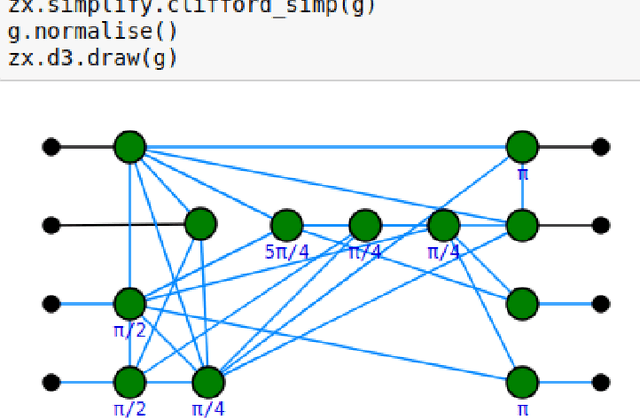
Abstract:This paper is a `spiritual child' of the 2005 lecture notes Kindergarten Quantum Mechanics, which showed how a simple, pictorial extension of Dirac notation allowed several quantum features to be easily expressed and derived, using language even a kindergartner can understand. Central to that approach was the use of pictures and pictorial transformation rules to understand and derive features of quantum theory and computation. However, this approach left many wondering `where's the beef?' In other words, was this new approach capable of producing new results, or was it simply an aesthetically pleasing way to restate stuff we already know? The aim of this sequel paper is to say `here's the beef!', and highlight some of the major results of the approach advocated in Kindergarten Quantum Mechanics, and how they are being applied to tackle practical problems on real quantum computers. We will focus mainly on what has become the Swiss army knife of the pictorial formalism: the ZX-calculus. First we look at some of the ideas behind the ZX-calculus, comparing and contrasting it with the usual quantum circuit formalism. We then survey results from the past 2 years falling into three categories: (1) completeness of the rules of the ZX-calculus, (2) state-of-the-art quantum circuit optimisation results in commercial and open-source quantum compilers relying on ZX, and (3) the use of ZX in translating real-world stuff like natural language into quantum circuits that can be run on today's (very limited) quantum hardware. We also take the title literally, and outline an ongoing experiment aiming to show that ZX-calculus enables children to do cutting-edge quantum computing stuff. If anything, this would truly confirm that `kindergarten quantum mechanics' wasn't just a joke.
Causal Inference by String Diagram Surgery
Nov 20, 2018Abstract:Extracting causal relationships from observed correlations is a growing area in probabilistic reasoning, originating with the seminal work of Pearl and others from the early 1990s. This paper develops a new, categorically oriented view based on a clear distinction between syntax (string diagrams) and semantics (stochastic matrices), connected via interpretations as structure-preserving functors. A key notion in the identification of causal effects is that of an intervention, whereby a variable is forcefully set to a particular value independent of any prior propensities. We represent the effect of such an intervention as an endofunctor which performs `string diagram surgery' within the syntactic category of string diagrams. This diagram surgery in turn yields a new, interventional distribution via the interpretation functor. While in general there is no way to compute interventional distributions purely from observed data, we show that this is possible in certain special cases using a calculational tool called comb disintegration. We demonstrate the use of this technique on a well-known toy example, where we predict the causal effect of smoking on cancer in the presence of a confounding common cause. After developing this specific example, we show this technique provides simple sufficient conditions for computing interventions which apply to a wide variety of situations considered in the causal inference literature.
Synthesising Graphical Theories
Apr 17, 2012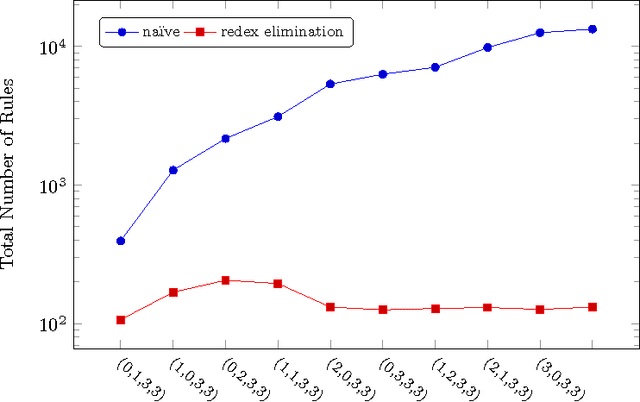
Abstract:In recent years, diagrammatic languages have been shown to be a powerful and expressive tool for reasoning about physical, logical, and semantic processes represented as morphisms in a monoidal category. In particular, categorical quantum mechanics, or "Quantum Picturalism", aims to turn concrete features of quantum theory into abstract structural properties, expressed in the form of diagrammatic identities. One way we search for these properties is to start with a concrete model (e.g. a set of linear maps or finite relations) and start composing generators into diagrams and looking for graphical identities. Naively, we could automate this procedure by enumerating all diagrams up to a given size and check for equalities, but this is intractable in practice because it produces far too many equations. Luckily, many of these identities are not primitive, but rather derivable from simpler ones. In 2010, Johansson, Dixon, and Bundy developed a technique called conjecture synthesis for automatically generating conjectured term equations to feed into an inductive theorem prover. In this extended abstract, we adapt this technique to diagrammatic theories, expressed as graph rewrite systems, and demonstrate its application by synthesising a graphical theory for studying entangled quantum states.
Pictures of Processes: Automated Graph Rewriting for Monoidal Categories and Applications to Quantum Computing
Mar 22, 2012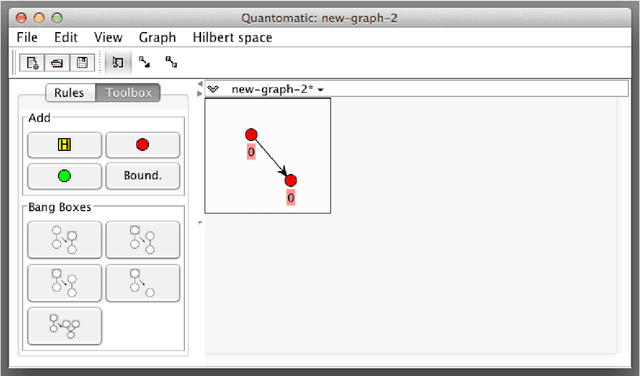
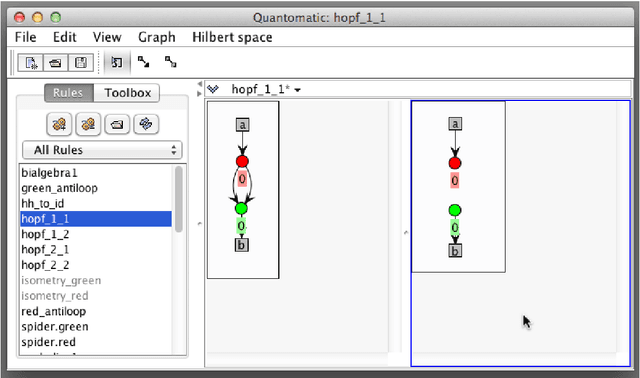
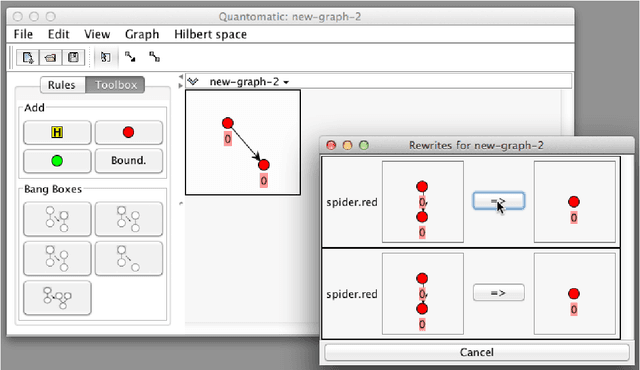
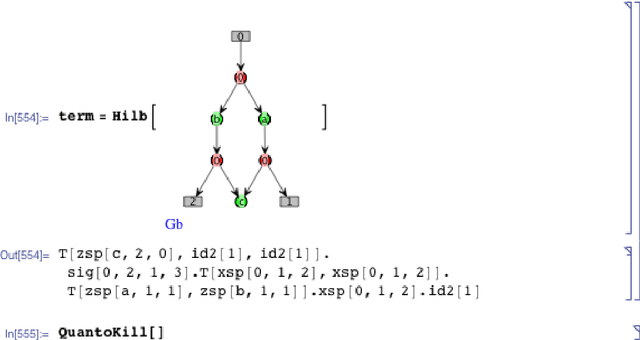
Abstract:This work is about diagrammatic languages, how they can be represented, and what they in turn can be used to represent. More specifically, it focuses on representations and applications of string diagrams. String diagrams are used to represent a collection of processes, depicted as "boxes" with multiple (typed) inputs and outputs, depicted as "wires". If we allow plugging input and output wires together, we can intuitively represent complex compositions of processes, formalised as morphisms in a monoidal category. [...] The first major contribution of this dissertation is the introduction of a discretised version of a string diagram called a string graph. String graphs form a partial adhesive category, so they can be manipulated using double-pushout graph rewriting. Furthermore, we show how string graphs modulo a rewrite system can be used to construct free symmetric traced and compact closed categories on a monoidal signature. The second contribution is in the application of graphical languages to quantum information theory. We use a mixture of diagrammatic and algebraic techniques to prove a new classification result for strongly complementary observables. [...] We also introduce a graphical language for multipartite entanglement and illustrate a simple graphical axiom that distinguishes the two maximally-entangled tripartite qubit states: GHZ and W. [...] The third contribution is a description of two software tools developed in part by the author to implement much of the theoretical content described here. The first tool is Quantomatic, a desktop application for building string graphs and graphical theories, as well as performing automated graph rewriting visually. The second is QuantoCoSy, which performs fully automated, model-driven theory creation using a procedure called conjecture synthesis.
 Add to Chrome
Add to Chrome Add to Firefox
Add to Firefox Add to Edge
Add to Edge